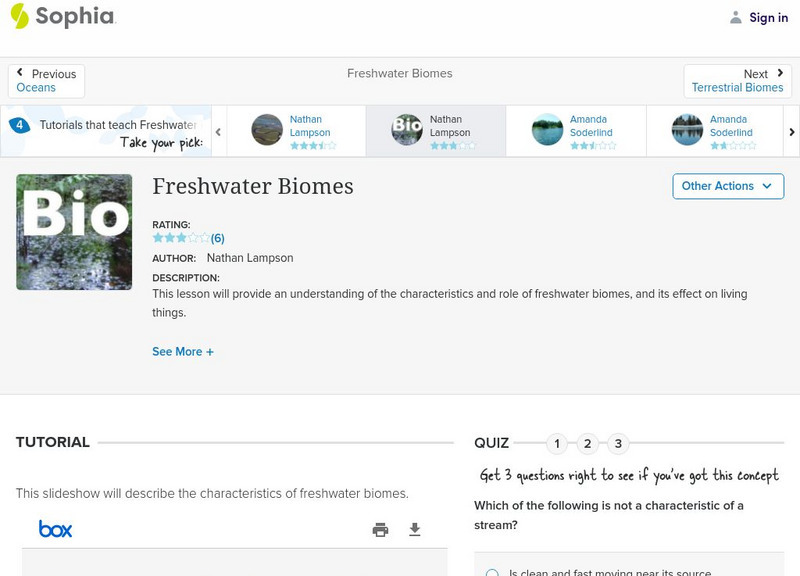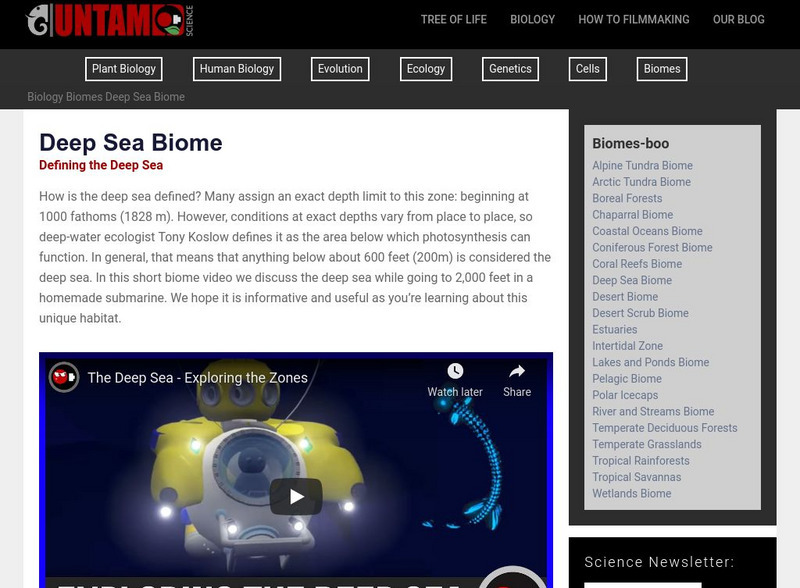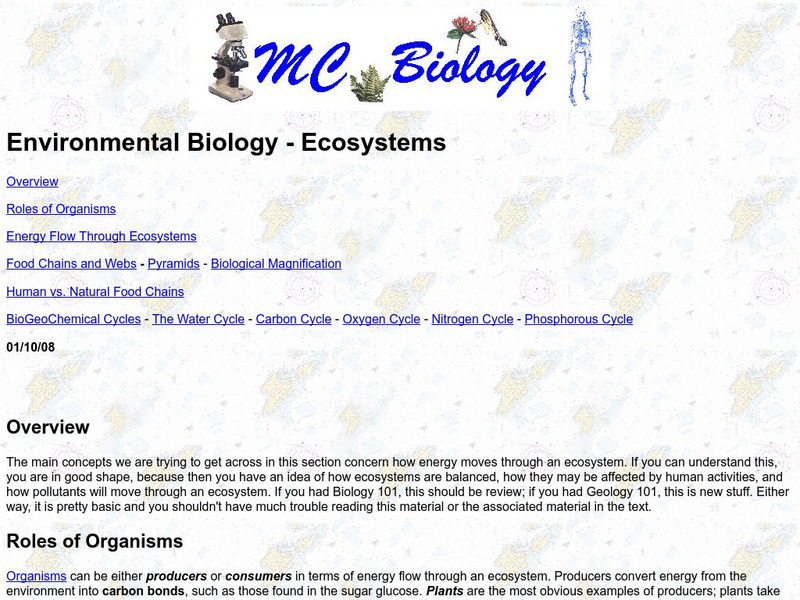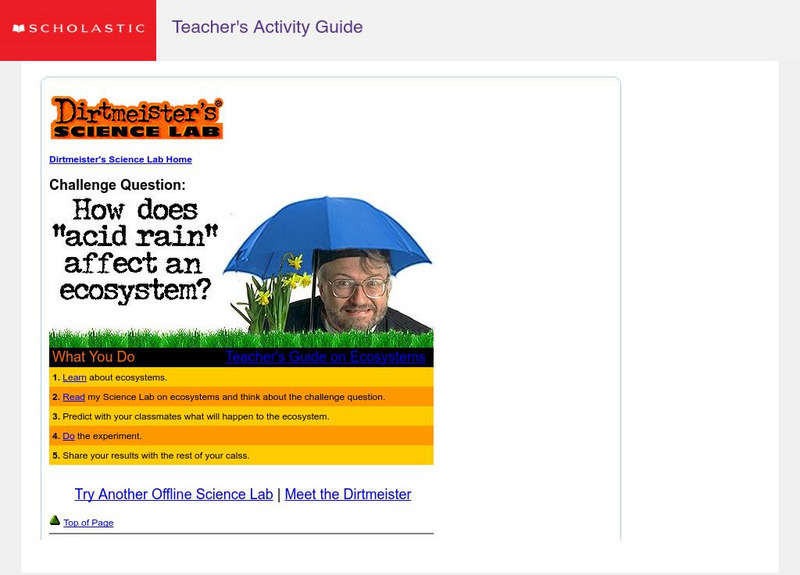Sophia Learning
Sophia: Freshwater Biomes
This colorful slideshow provides a nice introduction to the freshwater biomes around the world.
Untamed Science
Untamed Science: Biology: World Biomes: Deep Sea Biome
Read about the different zones and life in the deep sea as well as watch videos and examine photos of this aquatic biome. [5:54]
Science Struck
Science Struck: Facts About the Marine Biome
Describes the characteristics of the marine biome, the plants and animals that live in each of the four ocean zones, coral reefs and estuaries, the climate of the marine biome, and the marine food web.
Other
Marietta College: Biology: Energy Flow Through the Ecosystem
Read to understand how energy and inorganic nutrients flow through a food chain in an ecosystem.
Ducksters
Ducksters: Science for Kids: Tropical Rainforest Biome
Kids learn about the tropical rainforest biome. This diverse ecosystem produces much of the Earth's biodiversity.
Ducksters
Ducksters: Science for Kids: Savanna Grasslands Biome
Kids learn about the savanna grasslands biome. This tropical ecosystem is full of large herbivores like zebras, giraffes, and wildebeests.
Ducksters
Ducksters: Science for Kids: Tundra Biome
Kids learn about the tundra grasslands biome. This cold and dry ecosystem is located far to the north.
Ducksters
Ducksters: Science for Kids: Taiga Forest Biome
Kids learn about the taiga forest biome. The largest of the land biomes is known for its evergreen trees.
Ducksters
Ducksters: Science for Kids: Temperate Forest Biome
Kids learn about the temperate forest biome. Four distinct seasons and lots of trees.
The Environmental Literacy Council
Environmental Literacy Council: Ecosystems
Article explaining ecosystems and why we use them to organize our ideas about the natural world. Links to additional resources, maps, and activities.
Missouri Botanical Garden
Missouri Botanical Garden: Biology of Plants: Plant Adaptations
Read about how plants adapt to survive in different biomes. Includes a song, game, photos, and lesson plans.
Ohio State University
Ohio State University: General Plant Biology: Biomes and Agriculture
An introduction to biomes and how agriculture is considered in studying large ecosystems of the world. Text is well written and easy to follow with links, charts, and pictures.
National Earth Science Teachers Association
Windows to the Universe: Climate Changes With Latitude
A map showing the division of the world into eight biomes based on different climate types around the world. There are links to more information about each biome.
Alabama Learning Exchange
Alex: Abc Book of Fauna
This lesson is to provide students the opportunity to explore the various types of fauna (animals) found in the various biomes throughout the world.
Scholastic
Scholastic: Dirtmeister's Science Lab: Acid Rain
Step into Dirtmeister's Science Lab as he sets out to answer the challenge question: "How does acid rain affect an ecosystem?" Learn about ecosystems, make your predictions and then do the experiment.
Alabama Learning Exchange
Alex: Making and Observing Life in a Terrarium
For this lesson, the students will learn what a terrarium is, the layers of a terrarium, and the function of these layers. They will see how these components work together to create an ecosystem. This lesson plan was created as a result...
Ducksters
Ducksters: Science for Kids: Desert Biome
Kids learn about the desert biome. The dryest areas on Earth still have plant and animal life.
ClassFlow
Class Flow: Ecosystems
[Free Registration/Login Required] This flipchart explores the different ecosystems of the world, enhanced by embedded videos showing both the landscape and the plants and animals that can be found there.
ClassFlow
Class Flow: Understanding Ecosystems
[Free Registration/Login Required] This flipchart will help students to learn about ecosystems and the living and nonliving things that interact in them.
ClassFlow
Class Flow: Understanding Ecosystems: Part 1 of 4
[Free Registration/Login Required] Students will get an introduction to ecosystems. They will be able to distinguish nonliving and living thins in a habitat.
ClassFlow
Class Flow: Energy in Ecosystems Habitat
[Free Registration/Login Required] This flipchart discusses the habitats in ecosystems.
ClassFlow
Class Flow: Ecosystems
[Free Registration/Login Required] A flipchart covering the concepts and ideas required to understand ecosystems, with particular concentration on the tropical rain forest.
Morning Earth
Biosphere as Place: Ocean: Benthic Biomes Two
study the Biology concept of ecosystems. The marine ecosystem tutorial comprises of definitions, pictures, and examples of an assortment of ocean benthic biomes.
Morning Earth
Biosphere as Place: Ocean Benthic Biomes One
Students investigate the Biology topic of ecosystems. The marine ecosystem tutorial consists of definitions, pictures, and examples of different ocean-benthic biomes.






















